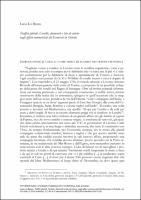Chapter Traffici globali. Corallo, diamanti e tele di cotone negli affari commerciali dei Genovesi in Oriente
| dc.contributor.author | LO BASSO, Luca | |
| dc.date.accessioned | 2022-06-01T12:11:22Z | |
| dc.date.available | 2022-06-01T12:11:22Z | |
| dc.date.issued | 2019 | |
| dc.identifier | ONIX_20220601_9788864538570_205 | |
| dc.identifier.issn | 2704-5668 | |
| dc.identifier.uri | https://library.oapen.org/handle/20.500.12657/56022 | |
| dc.description.abstract | Genoese merchants, who certainly did not disappear after 1627, during the second half of the century were able to establish new global-scale commercial networks on a par with those of other merchant communities (those of the Jews for instance). In the 1660s and for a few decades, Genoese goods – paper and fabrics – sailed to the Indies with African slaves. On their way back, the same Genoese ships would carry tonnes of silver and a wealth of other colonial goods thereby increasing trade with the East. This commercial framework is the backdrop to the story of Nicolò and Pietro Francesco Fieschi, two brothers whose lives testify how between the second half of the seventeenth century and the early decades of the eighteenth century, merchants from Genoa certainly had not withdrawn from international commerce focusing only on financial profits. On the contrary they were able to find new commercial momentum in opportunities provided by the connections brought about by the ever-more globalised world. | |
| dc.language | Italian | |
| dc.relation.ispartofseries | Atti delle «Settimane di Studi» e altri Convegni | |
| dc.title | Chapter Traffici globali. Corallo, diamanti e tele di cotone negli affari commerciali dei Genovesi in Oriente | |
| dc.type | chapter | |
| oapen.identifier.doi | 10.36253/978-88-6453-857-0.28 | |
| oapen.relation.isPublishedBy | bf65d21a-78e5-4ba2-983a-dbfa90962870 | |
| oapen.relation.isbn | 9788864538570 | |
| oapen.series.number | 50 | |
| oapen.pages | 22 | |
| oapen.place.publication | Florence |

